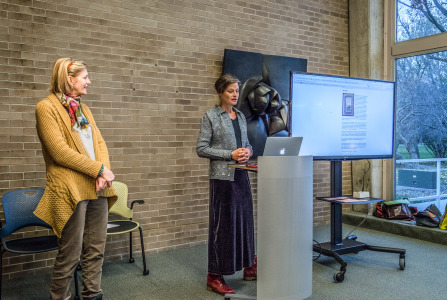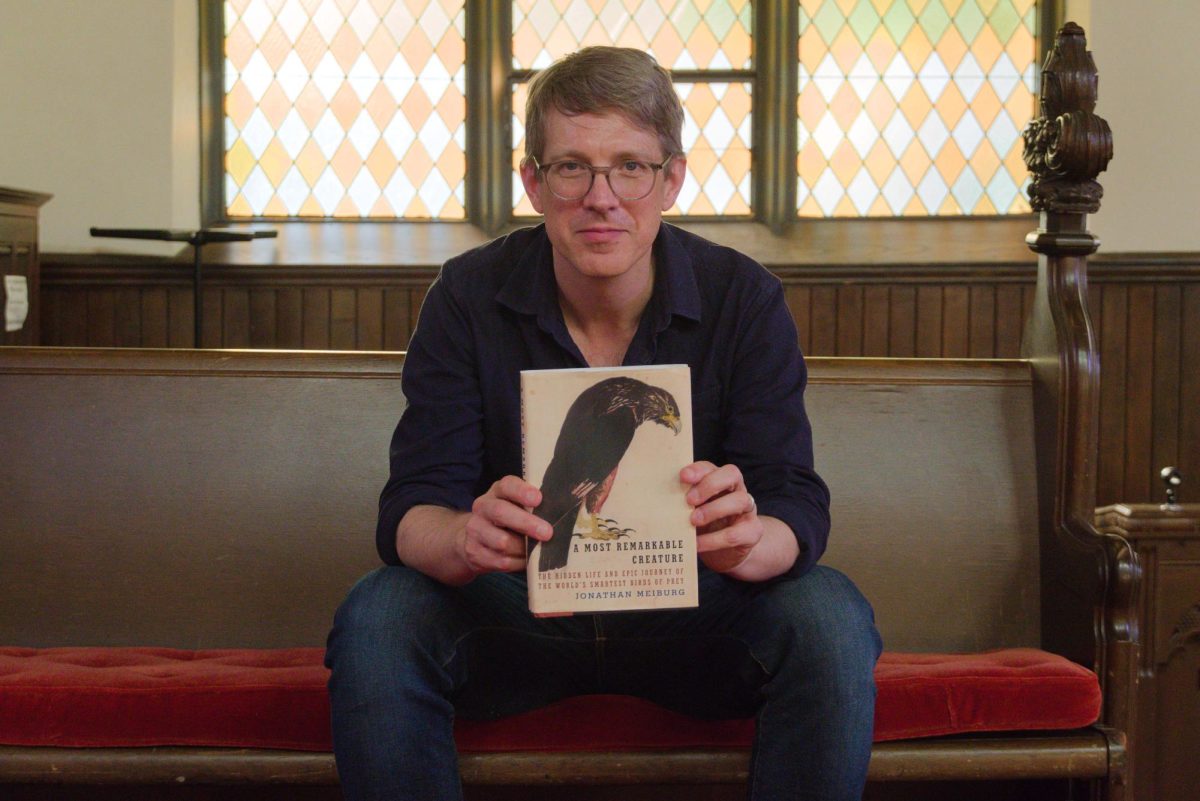
Alums Laura “Lola” Baltzell and Christiane Carney Johnson (both ’83) spoke to a small crowd in Burling lounge on Wednesday night about the “War and Peace” Project, a collaborative fusion of art and literature that visually reinterprets every page of Leo Tolstoy’s 1869 novel “War and Peace.” Baltzell led a team of eight artists, affectionately called “Team Tolstoy,” in the two and a half year project that ultimately created 747 mixed media collages.
“I started the project in winter of 2009 following a serious health crisis,” Baltzell said. “I wanted to do a long-term project that would encourage me to keep going—a project that engaged me and was fun.”
When she started, Baltzell was working alone. She tore pages from the copy of “War and Peace” that she bought while studying abroad in Leningrad and made collages out of each page. After six collages, she decided she would need help if she wanted to finish the project.
“I did six collages on my own and then said to myself, ‘Wow, I’m not sure I have the energy to do 741 more,’” Baltzell said. “A friend of mine was diagnosed with a significant health problem and I suggested as part of her recovery she could work on this project with me. She was doing chemo at the time, and would be lying of the floor and get up to make the collages. But she said that it helped pull her through chemo.”
Soon, the pair invited more friends to help with the undertaking, and Team Tolstoy was born. A menagerie of eight artists—six of whom are Grinnell alumni—met in Boston every Friday to share materials and create the collages. About 20 of the 147 collages came from one-time contributing artists, some from as far away as Berlin.
“Dealing with artists is like herding cats,” Baltzell said. “And I felt like I had to have some order so I made some rules. Each piece would be five by seven inches, there was no editing once a piece was finished, there had to be at least one word from the original Russian text on each collage and another rule that wasn’t fully enforced was that we didn’t buy materials.”
The collaborative nature of the project is documented on the project’s blog, where the artists wrote reflections on the each collage they created.
“We had two renegades on the team,” Baltzell said. “They didn’t like to go the text as much as play with materials. Collage 324 was done by Emma [Rhodes], and she wrote about it on the blog: ‘Here I was following Lucy [Arrington’s] lead … using diluted ink, a large ink brush and a new material that I brought to the studio called pan pastels—a pastel powder in a little dish that you apply with a make-up sponge. So much fun!’”
Johnson explained that the look of the collages can tune you in to where it fits chronologically within the novel.
“When the artist got the page they would read it and feel what Tolstoy was saying,” Johnson said. “You’d feel emotions that would help you choose the ink, paper and color. In the book’s war scenes there are collages that are just red and black that make you cringe.”
Johnson joined the project when it was about halfway done and sent an email explaining what Team Tolstoy was doing to the people at Yasnaya Polyana, Leo Tolstoy’s Estate and Museum in Tula, Russia. Two days later, she received a response.
“The response was basically, ‘This is amazing, when can you come?’” Johnson said. “And we were floored. So the four of us went on a pre-planning trip hosted by Tolstoy’s great-great-great grandson.”
The show at the Tolstoy estate opened in 2012 and the artists offered workshops in collaborative collage-making.
“They loved it, because in 2011 Russia was opened up and everything from the West had moved in,” Johnson said. “Young people are busy playing with iPads and no one is reading literature in their free time. So they thought it was a fantastic way for people to visually read the book.”
After the talk, Baltzell and Johnson answered questions from the audience. When asked how she hoped people would respond to the project if they have never read Tolstoy, Baltzell responded, “When I started, I had no intention of going beyond my own personal project. But over time it took on a life of its own … When people see it now I hope that they get a sense that the whole is greater than the parts—each artist has maintained their own voice and yet there is a wholeness in it.”


















































